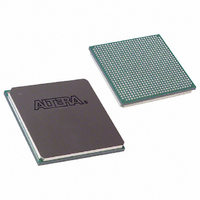EP2SGX30DF780C5N Altera, EP2SGX30DF780C5N Datasheet - Page 168

EP2SGX30DF780C5N
Manufacturer Part Number
EP2SGX30DF780C5N
Description
IC STRATIX II GX 30K 780-FBGA
Manufacturer
Altera
Series
Stratix® II GXr
Datasheet
1.EP2SGX30DF780C5.pdf
(316 pages)
Specifications of EP2SGX30DF780C5N
Number Of Logic Elements/cells
33880
Number Of Labs/clbs
1694
Total Ram Bits
1369728
Number Of I /o
361
Voltage - Supply
1.15 V ~ 1.25 V
Mounting Type
Surface Mount
Operating Temperature
0°C ~ 70°C
Package / Case
780-FBGA
Family Name
Stratix II GX
Number Of Logic Blocks/elements
33880
# I/os (max)
361
Frequency (max)
609.76MHz
Process Technology
SRAM
Operating Supply Voltage (typ)
1.2V
Logic Cells
33880
Ram Bits
1369728
Operating Supply Voltage (min)
1.15V
Operating Supply Voltage (max)
1.25V
Operating Temp Range
0C to 85C
Operating Temperature Classification
Commercial
Mounting
Surface Mount
Pin Count
780
Package Type
FC-FBGA
Lead Free Status / RoHS Status
Lead free / RoHS Compliant
Number Of Gates
-
Lead Free Status / Rohs Status
Compliant
Other names
544-1754
Available stocks
Company
Part Number
Manufacturer
Quantity
Price
Part Number:
EP2SGX30DF780C5N
Manufacturer:
ALTERA/阿尔特拉
Quantity:
20 000
- Current page: 168 of 316
- Download datasheet (2Mb)
Automated Single Event Upset (SEU) Detection
Automated
Single Event
Upset (SEU)
Detection
3–12
Stratix II GX Device Handbook, Volume 1
f
The temperature sensing diode is a very sensitive circuit which can be
influenced by noise coupled from other traces on the board, and possibly
within the device package itself, depending on device usage. The
interfacing device registers temperature based on millivolts of difference
as seen at the TSD. Switching I/O near the TSD pins can affect the
temperature reading. Altera recommends you take temperature readings
during periods of no activity in the device (for example, standby mode
where no clocks are toggling in the device), such as when the nearby I/Os
are at a DC state, and disable clock networks in the device.
Stratix II GX devices offer on-chip circuitry for automated checking of
single event upset (SEU) detection. Some applications that require the
device to operate error free at high elevations or in close proximity to
Earth’s North or South Pole will require periodic checks to ensure
continued data integrity. The error detection cyclic redundancy check
(CRC) feature controlled by the Device & Pin Options dialog box in the
Quartus II software uses a 32-bit CRC circuit to ensure data reliability and
is one of the best options for mitigating SEU.
You can implement the error detection CRC feature with existing circuitry
in Stratix II GX devices, eliminating the need for external logic.
Stratix II GX devices compute CRC during configuration and checks the
computed-CRC against an automatically computed CRC during normal
operation. The CRC_ERROR pin reports a soft error when configuration
SRAM data is corrupted, triggering device reconfiguration.
Custom-Built Circuitry
Dedicated circuitry is built into Stratix II GX devices to automatically
perform error detection. This circuitry constantly checks for errors in the
configuration SRAM cells while the device is in user mode. You can
monitor one external pin for the error and use it to trigger a
reconfiguration cycle. You can select the desired time between checks by
adjusting a built-in clock divider.
Software Interface
Beginning with version 4.1 of the Quartus II software, you can turn on the
automated error detection CRC feature in the Device & Pin Options
dialog box. This dialog box allows you to enable the feature and set the
internal frequency of the CRC between 400 kHz to 50 MHz. This controls
the rate that the CRC circuitry verifies the internal configuration SRAM
bits in the Stratix II GX FPGA.
For more information on CRC, refer to
in Altera FPGA
Devices.
AN 357: Error Detection Using CRC
Altera Corporation
October 2007
Related parts for EP2SGX30DF780C5N
Image
Part Number
Description
Manufacturer
Datasheet
Request
R

Part Number:
Description:
CYCLONE II STARTER KIT EP2C20N
Manufacturer:
Altera
Datasheet:

Part Number:
Description:
CPLD, EP610 Family, ECMOS Process, 300 Gates, 16 Macro Cells, 16 Reg., 16 User I/Os, 5V Supply, 35 Speed Grade, 24DIP
Manufacturer:
Altera Corporation
Datasheet:

Part Number:
Description:
CPLD, EP610 Family, ECMOS Process, 300 Gates, 16 Macro Cells, 16 Reg., 16 User I/Os, 5V Supply, 15 Speed Grade, 24DIP
Manufacturer:
Altera Corporation
Datasheet:

Part Number:
Description:
Manufacturer:
Altera Corporation
Datasheet:

Part Number:
Description:
CPLD, EP610 Family, ECMOS Process, 300 Gates, 16 Macro Cells, 16 Reg., 16 User I/Os, 5V Supply, 30 Speed Grade, 24DIP
Manufacturer:
Altera Corporation
Datasheet:

Part Number:
Description:
High-performance, low-power erasable programmable logic devices with 8 macrocells, 10ns
Manufacturer:
Altera Corporation
Datasheet:

Part Number:
Description:
High-performance, low-power erasable programmable logic devices with 8 macrocells, 7ns
Manufacturer:
Altera Corporation
Datasheet:

Part Number:
Description:
Classic EPLD
Manufacturer:
Altera Corporation
Datasheet:

Part Number:
Description:
High-performance, low-power erasable programmable logic devices with 8 macrocells, 10ns
Manufacturer:
Altera Corporation
Datasheet:

Part Number:
Description:
Manufacturer:
Altera Corporation
Datasheet:

Part Number:
Description:
Manufacturer:
Altera Corporation
Datasheet:

Part Number:
Description:
Manufacturer:
Altera Corporation
Datasheet:

Part Number:
Description:
CPLD, EP610 Family, ECMOS Process, 300 Gates, 16 Macro Cells, 16 Reg., 16 User I/Os, 5V Supply, 25 Speed Grade, 24DIP
Manufacturer:
Altera Corporation
Datasheet:












